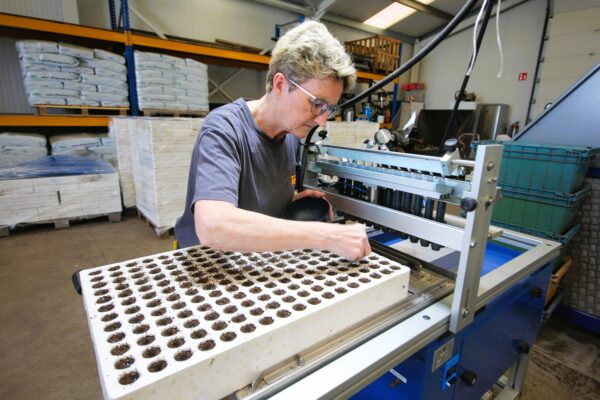Hordijk EPS Packaging & Insulation Products, in collaboration with Tenax Tree Plugs & Seeds, has developed an extra-rigid EPS tray for growing young tree seedlings. For Niels Dictus, these trays are the ideal solution for cultivating his one-year-old saplings with the right quality. “A tree is planted somewhere and remains there for decades, so everything has to function properly.”
Tenax Tree Plugs & Seeds is beautifully located along the Overasebaan, a country road surrounded by forests and meadows that winds its way to the rustic Brabant village of Rijsbergen. At first glance, the company of Niels Dictus and his wife Cindy resembles many other agricultural enterprises in the region. But appearances are deceiving—Tenax’s activities are far from ordinary. “Our business has two branches,” Dictus explains. “In a special germination setup, we pre-treat all kinds of seeds. With that solid foundation, we can give growers at home and abroad a significant head start. In addition, we cultivate plug plants—young trees with root balls, intended for commercial forestry throughout Europe.”
70,000 Trays
The seedlings are raised in two long rows of mint-green tunnels on the premises. Each tunnel houses over a thousand EPS trays, which—aside from a narrow walkway—cover the ground like a tightly fitted puzzle. “This is our most used 204-tray,” says Dictus, holding it like a tray in front of him. The more than 200 holes in the tray are each filled with a paper-wrapped mix of potting soil and a blue seed. “Within a year, we grow the seedlings to about fifteen centimeters tall. Can you imagine that such a small plant eventually becomes a 30-meter tree? We have nearly 2.4 million of just the Douglas fir seedlings, used for things like pergolas. We also grow larch, beech, miniature Christmas trees, and Japanese asters for ornamental use. In total, we handle 70,000 trays and ten to eleven million plants per year.”
Optimal Root Growth
The EPS tray design offers several advantages. The trays (40 x 60 cm) are highly compressed, causing the roots to naturally grow along the EPS surface. “That’s crucial,” says Dictus. “A tree has a main root and lateral roots that are very strong. If the tray isn’t well compressed, the roots quickly penetrate the material. The high compression prevents that.” The generous depth (8 cm) and the internal shape also support healthy growth. “The tray tapers slightly inside and has ridges, so the roots can’t spiral around. They bump into the edges and then always grow downward.”
Root growth is also stimulated because the holes are open at the bottom. “Each root that emerges from the bottom comes into contact with air and light—especially air is important. That triggers air pruning and causes the plant to develop many fine roots inside. This is essential for regrowth at our clients’ sites. A tree is planted to stay for decades, so it all needs to work well.”
Thanks to EPS’s insulating properties, the vulnerable young plants are also better protected. Temperature fluctuations are less harsh on the roots. Dictus sees that as another advantage. “With black plastic trays, the root zone can burn on the sun-facing side because the material gets so hot. EPS keeps out the heat on warm days. In winter, it helps insulate against the cold—although if there’s a hard frost, we still need to thaw the plants. EPS also retains a bit of moisture from the potting soil, which is later released back to the plant.”
Long Lifespan and Recycling
Tenax reuses the trays for five years. Dictus notes that over time, they become more porous. “Then you get more root growth into the material, and the tray absorbs too much moisture, which isn’t ideal. Harmful fungi can also settle in and lie dormant, ready to cause damage in the next season. That’s why we work on a five-year cycle—reusing and thoroughly cleaning the trays each time. After that, we buy a new batch of about 15,000 trays from Hordijk.”
The old trays are collected and recycled. The EPS is given a second life as insulation boards for the construction and civil engineering industries. “That’s great. The material is reused, and I feel good about that. Although I must admit, at the moment recycling is also a bit cheaper than incineration.”
Seedlings of Consistently High Quality
More and more farmers are growing crops above ground in trays, pots, and containers—sometimes for economic reasons, sometimes due to strict EU regulations. For Dictus, the use of trays is mainly about efficiency. The cultivation process is easier to control, and the plants reach the high, consistent quality he envisions. Growing in tunnels is also a personal choice, rooted in his childhood. “My father used to grow the plants directly in the soil. That was fine in summer, but in winter, wading through mud to pull the plants out—yeah, that wasn’t really my thing. I wanted to do it differently.”
Tenax initially bought similar EPS trays from another company. “But I thought, wouldn’t it be more cost-effective to have our own mold made? It took a while, but one day I simply searched for ‘EPS’ and found Hordijk. After several conversations, technical drawings, and a test print, we arrived at this great design together.”
Case Summary
- To grow young tree seedlings, Tenax uses a smartly designed EPS tray that holds over 200 plants.
- The tray is extra rigid, encouraging roots to grow smoothly along the surface.
- The generous depth and tapered shape of the holes promote healthy root development.
- Open bottoms of the holes stimulate natural air pruning, which strengthens the plants.
- The insulating properties of EPS moderate temperature fluctuations at the root level.
- The trays are reused for five years and then recycled into insulation products for construction and infrastructure.

